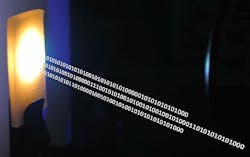Perovskite phosphor boosts data rates for visible-light communication
So-called visible-light communication (VLC) using white-light LEDs or laser diodes to transmit data to computers and other devices. The technique makes use of parts of the electromagnetic spectrum that are unregulated and is also potentially more energy-efficient than using radio waves. VLC also offers a way to combine information transmission with illumination and display technologies—for example, using ceiling lights to provide internet connections to laptops.
VLC can also greatly boost data rates in comparison to ordinary Wi-Fi. However, the existing yellow YAG phosphors used with gallium-nitride (GaN)-based blue LEDs to form white-light sources have a relatively slow decay time—much slower than the blue LED itself—reducing the data rate.
Now, researchers at King Abdullah University of Science and Technology (KAUST; Thuwal, Saudi Arabia) have created a nanocrystalline perovskite material that forms white light out of blue light and has a modulation bandwidth of 491 MHz—40 times that of the conventional phosphors.1 With this modulation rate, data could be transmitted at 2 Gbit/s.
Warm white light
The solution-processed cesium lead bromide (CsPbBr3) nanocrystals are roughly 8 nm in size and were combined with a nitride phosphor. When illuminated by blue laser light, the CsPbBr3 emitted green light while the nitride emitted red light. Together, these combined to create a warm white light.
(Another way to increase data rates for communications based on white-light semiconductor sources is to use three separate sources—a red (R), a green (G), and a blue (B)—instead of a single blue source used with phosphors. However, RGB light sources are more expensive than blue + phosphor sources.)
The researchers characterized the optical properties of the material using femtosecond transient spectroscopy. They showed that the optical processes in cesium lead bromide nanocrystals occur on a time-scale of roughly 7 ns.
“The rapid response is partly due to the size of the crystals,” says Osman Bakr, one of the researchers. “Spatial confinement makes it more likely that the electron will recombine with a hole and emit a photon.”
The white light generated using the perovskite nanostructures was of a quality comparable to present LED technology.
“We believe that white light generated using semiconductor lasers will one day replace LED white-light bulbs for energy-efficient lighting,” says Boon Ooi, another of the researchers.
Source: https://discovery.kaust.edu.sa/en/article/258/step-into-the-white-light-for-faster-communication
REFERENCE:
1. Ibrahim Dursun et al., ACS Photonics 3 (2016); doi: 10.1021/acsphotonics.6b00187
About the Author
John Wallace
Senior Technical Editor (1998-2022)
John Wallace was with Laser Focus World for nearly 25 years, retiring in late June 2022. He obtained a bachelor's degree in mechanical engineering and physics at Rutgers University and a master's in optical engineering at the University of Rochester. Before becoming an editor, John worked as an engineer at RCA, Exxon, Eastman Kodak, and GCA Corporation.

